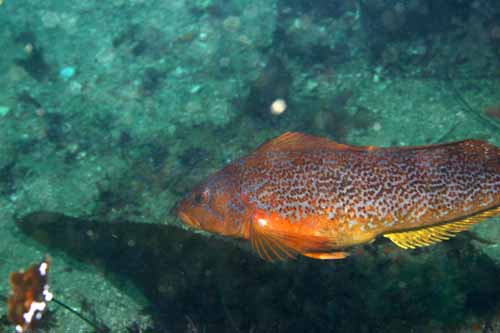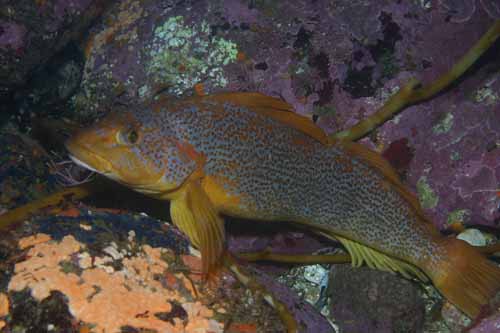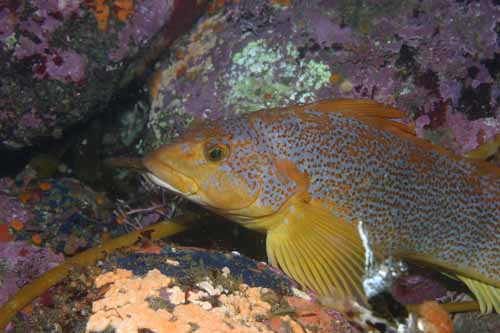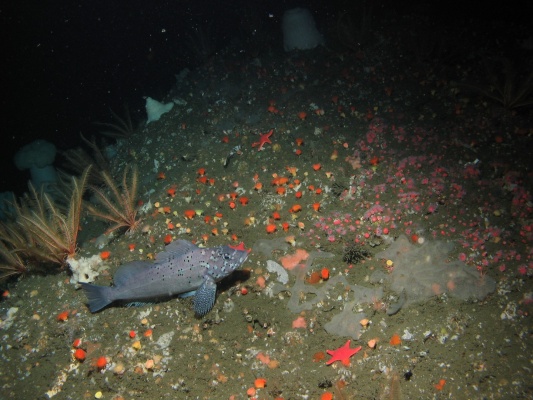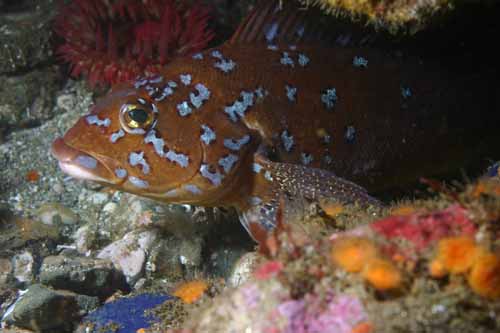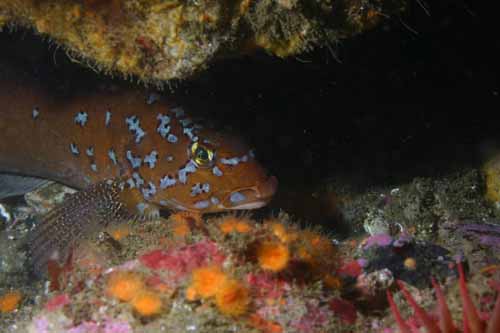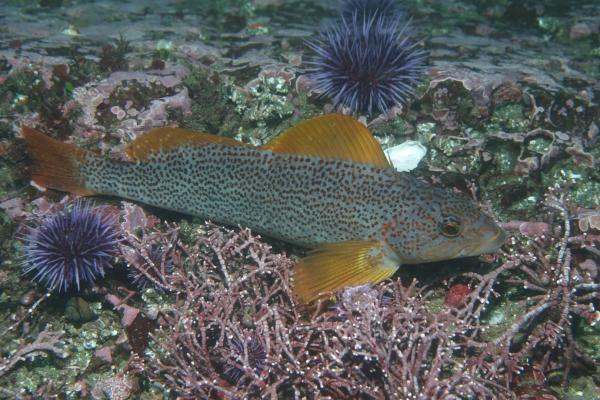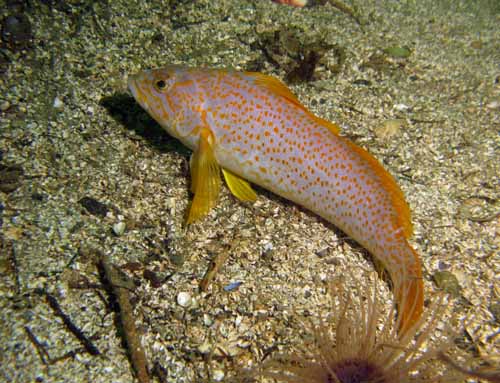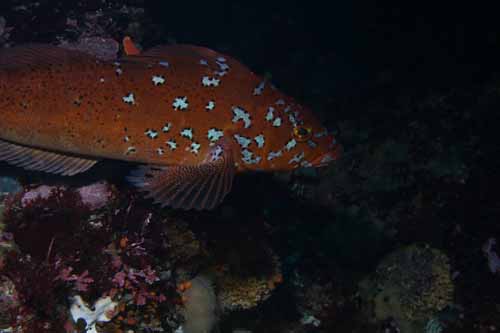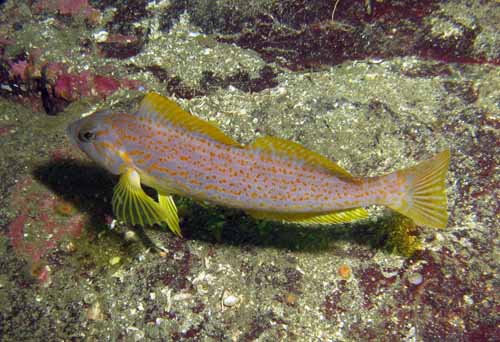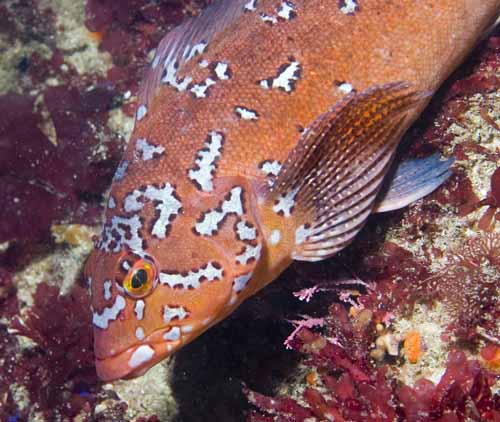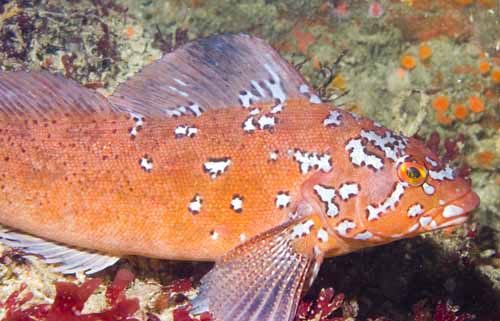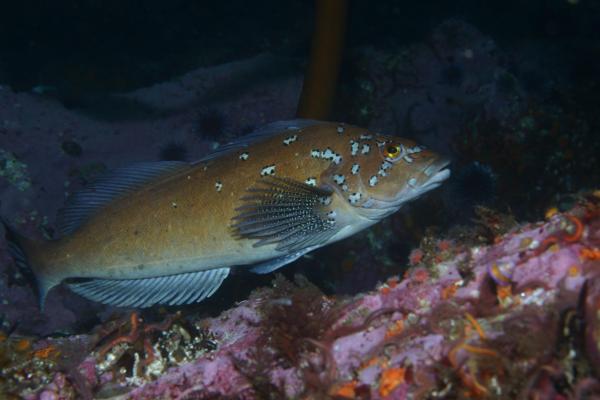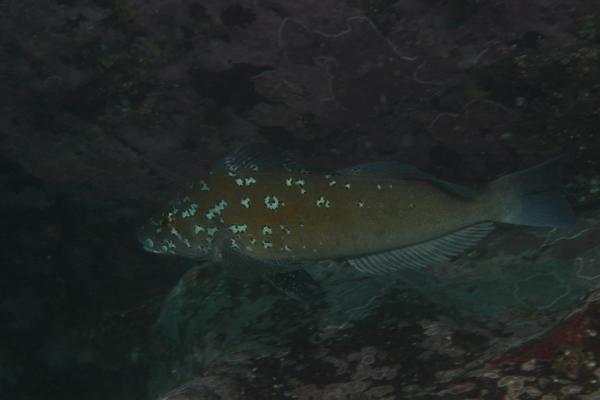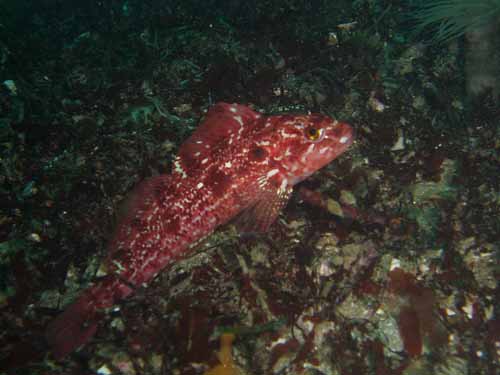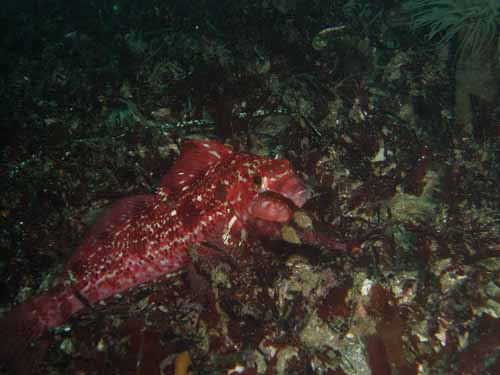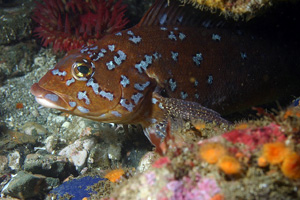
Kelp greenling
Hexagrammos decagrammus
Overview
Key Features:
Males are gray-brown with multiple small black spots and larger, iridescent, black-edge blue blotches near the head. Females are gray or light blue with hundreds of reddish-brown spots and golden-red pectoral fins.Similar Species:
Rock greenling (Hexagrammos lagocephalus)Primary Common Name:
Kelp greenlingGeneral Grouping:
Bony fishesGeographic Range:
Aleutian Islands, Alaska to La Jolla, California
Hexagrammos decagrammus ranges from Amchitka Island in the Aleutian Islands, Alaska, to La Jolla, California.Intertidal Height:
-2 to -1 feet (-0.6096 to -0.3003003 meters)Notes:
Occurs rarely in the intertidal.Subtidal Depth Range:
Minimum Depth: 0 meters or 0 feetMaximum Depth: 46 meters or 153.18 feet
Habitats:
bay (rocky shore), bay (sandy shore), Continental shelf, exposed rocky shore, exposed sandy beaches, kelp forest, protected rocky shore, protected sandy beachesNotes:
Hexagrammos decagrammus occupies rocky coastal waters from the intertidal to 46 meters deep. They are often found around rocky reef and in kelp beds, but can also be found on sand bottoms. Between Alaska and central California, most of these fish live from the lower intertidal to about 17 meters, with females tending to live shallower than males.Abundance:
Relative Abundance:
Hexagrammos decagrammus is abundant to common from the Aleutian Islands, Alaska to Washington. They are occasional from Oregon to central California and rare in southern CA.Species Description:
General:
Hexagrammos decagrammus belongs to the greenling family, Hexagrammidae and the scorpionfish and flathead order, Scorpaeniformes.Distinctive Features:
Hexagrammos decagrammus has an elongated, fusiform, and slightly compressed body. This is one of the few fish with five lateral lines, which makes it easily distinguishable. The fourth lateral line extends well beyond anal fin origin. The males and females have different body coloration. The males are grayish brown with many small black spots and larger, iridescent, black-edge blue spots. Females are gray or blue with reddish-brown spots. They have a moderately sharp snout, fleshy lips, and thread-like projections behind the eyes. The inside of the mouth is yellowish and palatine teeth are present. There is a pair of cirri over eyes with a length less than three-fourths eye diameter and another small pair located between the eyes and dorsal fin. On occasion, this second pair is absent. They have one long, deeply notched dorsal fin and the caudal fin is broadly rounded or truncate. They have ctenoid scales covering the opercle. Hexagrammos decagrammus has a total of 21-22 dorsal spines, 24 dorsal soft rays, 1 anal spine and 23-24 anal soft rays.The rock greenling, H. lagocephalus is a related species and can be distinguished by having a single pair of cirri over eyes with length more than three-quarters the eye diameter and their mouth is bluish inside. The whitespotted greenling, H. stelleri can be differentiated from Hexagrammos decagrammus by its white spots on back, the lack of palatine teeth and the fourth lateral line not extending beyond anal fin origin.
Size:
Hexagrammos decagrammus can grow to be 61 cm total length and a weight of 2100 grams.Natural History:
General:
Hexagrammos decagrammus has been aged to 12 years of age, but probably live a bit longer. A typical 25 cm fish is 6-9 years old. Females tend to grow faster than males. Some females mature by 3-4 years of age, but all are mature by 5 and at a size of about 24 cm. Hexagrammos decagrammus tends to be a solitary, territorial fish, and will even chase away other greenlings.Predator(s):
Young Hexagrammos decagrammus are food for steelhead, Oncorhynchus mykiss, and salmon. Oncorhynchus sp.. Adult Hexagrammos decagrammus are prized as a sport fish and frequently caught from central California northward by shore and skiff fishermen and speared by divers. There is not much of a commercial market for this fish.Prey:
Hexagrammos decagrammus will eat almost anything available to them, especially shrimps, small crabs, polychaete worms, small fishes, brittle stars, octopi, snails, and the siphons of clams.Feeding Behavior:
CarnivoreNotes:
Hexagrammos decagrammus feeds during the day and are inactive at night.Seasonal Behavior
September - November
Reproduction:
The oviparous Hexagrammos decagrammus spawns in the fall with nesting noted from October to November. Females migrate down to the males and lay pale blue eggs in nests. The males guard the egg masses until they hatch.References
- Alden, P., F. Heath, R. Keen, A. Leventer, and W. Zomlefer. 2002. National Audubon Society Field Guide to California. A.A. Knopf, New York, NY.
- Boschung, H.T., J.D. Williams, D.W. Gotshall, D.K. Caldwell, and M.C. Caldwell. 1998. National Audubon Society Field Guide to North American Fishes, Whales and Dolphins. A.A. Knoph, New York, NY. 848 p.
- Eschmeyer, W.N., and E.S. Herald. 1983. A Field Guide to Pacific Coast Fishes of North America. Houghton Mifflin Company, Boston, MA. 336 p.
- Froese, R. and D. Pauly (eds.). 2006 (Updated 01/02/06). FishBase. World Wide Web electronic publication. http://www.fishbase.org, Accessed [04/25/06].
- Gotshall, D. 2001. Pacific Coast Inshore Fishes. Sea Challengers, Monterey, CA. 117 p.
- Humann, P. 1996. Coastal fish identification : California to Alaska. New World Publications, Jacksonville, FL. 205 p.
- Love, M. 1996. Probably more than you want to know about the fishes of the Pacific Coast. Really Big Press, Santa Barbara, CA. 381 p.
Related Information
Photo Library
Click on an image below to view a larger version in the SIMoN Photo Library. You will also be able to view important information on each photo such as photographer, date, caption and more
